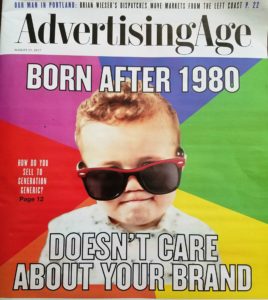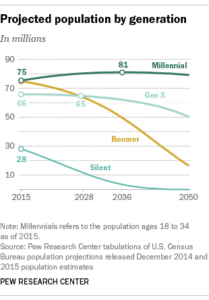Is Brand Loyalty Dying?
What does the future hold for brands? With millions of dollars being spent on brand campaigns, this represents a critical question. Few would argue that for brand development, times are changing. For marketers, there exist two critical times of major change. These are perhaps, at the moment, underestimated. Both have critical, even all-important, applications for brands and the future of brands.

The first is mid-year 2015, when the U.S. Census estimates that the Millennials overtook Boomers – the latter being the most influential, rich and educated generation in human history – in terms of numbers of people alive (within specific time periods). The second, and possibly more important, was the duration and aftermath of the Great Recession. For all intents and purposes, the Great Recession lasted from December 2007 to February 2010.
How does this relate to brands? How about this: can you say the “decline of traditional brands”? Or maybe even the “death of brands”?
Boomer marketers are obsessed with brands. Brand loyalty grips boomers at the heart of consumption. Boomers define themselves by the brands they choose.
Millennials don’t care about brands
According to Advertising Age, Millennials (those born after 1980), could not care less about brands. To many of them, brands are basically irrelevant. No amount of marketing or public relations can make a difference.
If that fact is true, it holds profound implication for brand development, brand campaigns, brand strategy.

See vacant tables at restaurants, particularly at lunchtime? See grocery carts (unless the products are being delivered a home, an important service for Millennials) full of private-label products, nearly completely devoid of name brand products so precious and important to boomers? Wonder why places like Trader Joe’s – which are full of private-label products – are packed, while mainstream retailers like Marsh (in Indiana) and H.H. Gregg are bankrupt?
The growing impact of millennials on brands
The expanding impact of Millennials is already being felt. And marketing needs to grab hold of this trend, if it hasn’t already.
How did this happen? One plausible explanation details how the Millennial generation first tasted its consumption power right when the global economy tanked. They emerged from college ready for their moment. It was not to be. They nearly sank from student debt. They couldn’t find jobs. They didn’t buy into the brand hammer of incessant brand advertising. They had the internet.
As marketers quickly found (or are finding out) Millennials don’t care about the brand promises of “whiter, cleaner, brighter.” As Ad Age reports: “The recession was definitely a trigger for this. It was a reconfiguration for millennials of how much of my hard-earned dollars have to go to large corporations and brands, and how much can I get of what I need to get for a lower price point.”
For certain, at the time of this writing, boomer influence remains high and boomers still buy branded products with a high degree of brand loyalty. That trend represents billions – even trillions – of dollars globally.
But that is shifting. Millennials have a trust issue. Faced with the need to purchase something, they go online. They read the star ratings. They see what experiences people are having.
And these forays concern products and services large and small.
What do Millennials want?
Millennials want to see that the companies that make their products have charitable interests pretty high up on the food chain. They want price points that are affordable. They will turn the bottles around to see whether the generic, private label products have the same ingredients as the major branded products and buy them (instead of the more expensive branded product).
Millennials live by life-hacking. They read online reviews. They demand transparency. If they see online reviews that are 100% positive, they dismiss them as bogus and edited by Big Brother. They know that nobody is perfect.
Is your company banking on accumulated brand loyalty? This might not be a viable strategy for the future. Instead, consider banking on providing high value and a prominent level of positive experience. Millennials are much more willing to experiment and try something new, particularly if the alternative has a much friendlier pocketbook experience.
Speaking of experience, did we mention customization? Online experiences are highly customizable. By way of prior Boomer background, terrestrial radio basically has zero customization. Plus, it has annoying brand commercials. So, Pandora and Spotify rake in new Millennial listeners who want to listen to what they want to listen to.
So, in addition to focusing on high-value products, what are other ways marketers, influencers, and communicators can effectively reach this emerging powerhouse generation?
Ad Age specifically cites four opportunities (and we’re all sure there’s more, but this is a good place to start):
Give Up Control – Developing a new product? Use crowdsourcing and collaborative methods and make that fact known. Millennials want to be involved.
Bring on the Activations – Personal connections with branded products and service can come about through brand activation. The involves creating a positive experience that the Millennial can associate with your brand.
Mix It Up – Digital advertising and high-value content must figure highly in a marketing mix that is aimed at Millennials. If your brand is old and established and a Boomer-originated brand, trying pairing with a new product or service and bask in the aura of a new Millennial focus.
Product Sourcing – Millennials obsess over how things are made. Be transparent and collaborative as new products and services are being contemplated or development. Invite participation.
Finally, don’t forget consumer packaging and apps. Just because it’s a new private label product or service is inexpensive doesn’t mean that it’s not visually attractive. And if your brand can be integrated into an app, don’t wait. Your competitors won’t be.
Brand narratives – real story-telling (not manufactured Madison Avenue/”Man Men” confectionaries) – make your brand/product/service real. Build trust. Make sure things work. And let the Millennials tell your story.
By Michael Snyder, managing principal, MEK Group.
